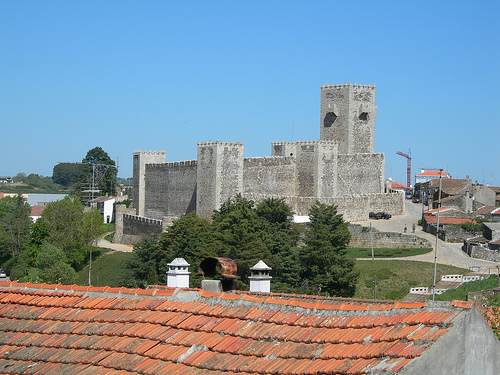

Location: Sabugal, Guarda District Map
Sabudal Castle is a medieval fortress situated in the city of Sabudal in Guarda District in the Central Portugal. Sabudal Castle was constructed in the late 13th century by King Dinis (1275-1325) on a hill overlooking crossing of Côa river. Protective walls of the castle consists of two walls that protect the inner courtyard, square towers and a barbican (fortified outpost). Its imposing keep known as "Torre das Cinco Quinas" reaches a height of 28 metre. In 1641 reconstruction of the medieval fortifications were undertaken to strengthen crumbling walls and tower. Fortress also got a clock tower around this time. During the third French invasion it served as a base for the Portuguese troops as well as British soldiers who aided them in struggle against the French forces.
According to archaeological evidence , it is
assumed that the elevation on which the present castle stands ,
dominating the course of the Côa river , has been occupied by humans
since prehistoric times , who would have erected a castro there .
With the Roman invasion of the Iberian Peninsula , an extensive
network of roads was cut across the peninsula, one crossing the Côa
in this stretch. It is assumed that this people maintained a small
military garrison on the same site for the surveillance and defense
of the river crossing. Centuries later, he became acquainted with
Germanic and Muslim peoples , of which no further evidence remained.
The medieval castle
At the time of the Christian Reconquest of the Iberian Peninsula ,
the lands of Sabugal were initially conquered possibly by D. Afonso
Henriques (1112-1185) in 1160 , soon to be lost to the kingdom of
León .
In 1190 , Alfonso IX de Leão created the Municipality of Sabugal,
and the village was founded around 1224 , when a defensive
stronghold was started.
A member of the territory of Ribacôa , conquered to Leo by D. Dinis
(1279-1325), received Letter of Foral of that Portuguese sovereign
in 1296 . However, his definitive possession for Portugal was only
ensured by the Treaty of Alcanices in 1297 . The sovereign, from
then sought to consolidate these boundaries, making rebuild the
Castle Tailors , the Castle of Almeida , the Castle Good , the
Castelo Melhor , the Castelo Mendo , the Castelo Rodrigo , the
pinhel castle , the Castle of Sabugaland the Vilar Maior Castle .
In this context, the works of enlargement and reform of its
castilian defense begin, clearing the intramural space where some
houses of the village were erected and reinforcing the walls that
gained by two great turrets dominated by a tall keep. . The works,
referred to by Rui de Pina ( Chronicle of D. Dinis ), were completed
in 1303 , under the direction of Friar Pedro, from the Alcobaça
Monastery . Is credited yet, to this sovereign, the establishment in
these areas, a coutohomized, a privilege that aimed to attract
people. Some documents confirm that this privilege was still in
force at the end of the 15th century .
In the reign of King Manuel I (1495-1521), the Sabugal Castle is
figured by Duarte de Armas ( Book of Fortresses , c. 1509 ), having
received beneficiation works, completed in 1515 , as epigraphic
inscription on the main gate. This sovereign granted the Foral Novo
to the villa on June 1 , 1515.
In the context of the War of Restoration , modernization works were
carried out in its structure, as well as later built the so-called
Clock Tower.
In the 17th century , the poet and knight Brás Garcia de Mascarenhas
was arrested , famous for his adventures and for his no less famous
epic poem Viriato Tragic.
In the early nineteenth century , in the context of the Peninsular
War , it quartered English and Portuguese troops who fought back the
retreating Napoleonic troops , under the command of General André
Masséna (April 1811 ). Subsequently unguarded and abandoned, its
square of arms was used by the population of the village as a
cemetery , from 1846 to about 1927 . In the meantime, the
inhabitants began to remove stones from the walls to reuse them in
their buildings.
In the twentieth century , in 1911 the Church of Nossa Senhora do
Castelo was demolished . Later, in the 1940s , the process of
depredation of the monument was halted thanks to the action of the
Directorate General of National Buildings and Monuments (DGEMN),
which promoted a broad campaign of consolidation and reconstruction
works.
Between 1993 and 1994 a new campaign of restoration work, seeking to
return to the monument its original features. More recently, with
evidence of cracks in the walls and partial collapse of elements
from one of the barbican's turrets and some battlements ( 1999 ) at
the dawn of the 21st century , DGEMN launched a tender for the
restoration and consolidation of the walls. and castle towers, as
well as the construction of an open -air amphitheater and its
supporting facilities ( 2001 ). Work was carried out between 2003
and 2005, when the monument was expected to reopen to the public.